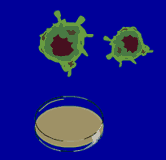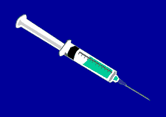
Step 1
Use the tissue culture to grow new viruses.
|
|
You are about to create a live-attenuated vaccine, which means
that you need to alter a pathogen—in this case a measles
virus—so that it will still invade cells in the body and
use those cells to make many copies of itself, just as would
any other live virus. The altered virus must be similar enough
to the original measles virus to stimulate an immune response,
but not so similar that it brings on the disease itself.
To create a new strain of the virus, you'll need to let it
grow in a tissue culture.
|

Step 2
Fill the syringe with a strain of the virus that has desirable
characteristics.
|
|
The tissue culture is an artificial growth medium for the
virus. You will intentionally make the environment of the
culture different than that of the natural human environment.
For this vaccine, you'll keep the culture at a lower
temperature.
Over time, the virus will evolve into strains that grow better
in the lower temperature. Strains that grow especially well in
this cooler environment are selected and allowed to evolve
into new strains. These strains are more likely to have a
difficult time growing in the warmer environment of the human
body. After many generations, a strain is selected that grows
slow enough in humans to allow the immune system to eliminate
it before it spreads.
|

Done
The measles vaccine is complete.
Select another pathogen.
|
|
Congratulations. You have just produced a live-attenuated
measles vaccine.
Like the smallpox vaccine, the virus within the vaccine will
invade body cells, multiply within the cells, then spread to
other body cells. The virus used in the measles vaccine today
took almost ten years to create. The starting stock for the
virus originated from a virus living in a child in 1954.
Live-attenuated vaccines are also used to protect the body
against mumps, rubella, polio, and yellow fever.
|

